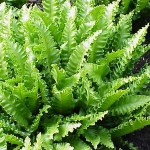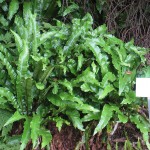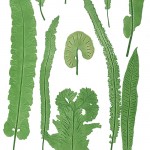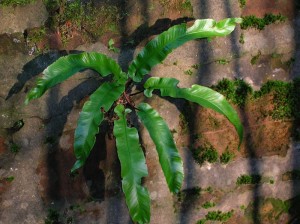Family: Aspleniaceae
Synonymous: Phyllitis scolopendrium
Scolopendrium vulgare
Asplenium altajense
Phyllitis japonica
Distribution and habitat: Asplenium scolopendrium is an evergreen fern widely distributed in central and southern Europe, eastern Iran, northwestern Africa, Korea, Japan, Sakhalin and scattered populations appear in eastern North America. It occurs at sites on or near dolomite (magnesium-rich limestone) that remain consistently moist year-round such as sinkholes, cave entrances, wooded limestone ravines and talus slopes and steep north-facing slopes with rich, moist soil. Within these sites, it is typically found in microhabitats such as moist crevices, moss mats, depressions, spray zones and shady cliff margins.
The common name is in reference to the supposed resemblance of the frond shape to a deers tongue.
Description: Asplenium scolopendrium is commonly grown as indoor plant. Tufts of fronds unfurl from an upright, branching rhizome that lies partly above, partly below the surface of the soil. The rhizome which is covered with light brown, furry scales, is usually hidden by the fronds stalks.
Depending on their age and growing conditions, the stalks are from 2 to 25cm (0.8-10 inch) long and their colour is usually black at the base shading to green at the point where they became the midrib of the bade. Frond blades are strap-like, pointed at the tip, lobed at the base and medium green in colour. In the wild each blade can grow 50cm (20 inch) long and 13cm (5 inch) wide, but in potted plants they are seldom more than half that size. The fronds grow erect at first, but arch over as they lengthen. Spore cases grow in a herringbone pattern on the beck of the most of them. The edges of blades can be undulate and sometimes frilled and the tip of each blade can be either pointed or crested like a cockscomb. These differently shaped blades can all be present at one time on the same plant. In fact, it is this characteristic of Asplenium scolopendrium that chiefly appeals to many indoor gardeners.
Asplenium scolopendrium is often grown as an ornamental plant, with several cultivars selected with varying frond form, including with frilled frond margins, forked fronds and cristate forms.
Houseplant care: Asplenium scolopendrium grow actively throughout the year under ideal condition. Growth slows down, however, during the short-day winter months.
Light: Medium light is best for these ferns throughout the year. They should never be subjected to direct sunlight which will scorch the fronds.
Temperature: Asplenium scolopendrium grows well in normal room temperatures and can also tolerate temperatures down to 10C (50F). These ferns need high humidity in warm positions. When the temperature rises above 18C (64F), stand the ferns on trays of damp pebbles.
Watering: Water moderately, giving enough at each watering to make the potting mixture moist throughout but allowing the top centimetre (0.4 inch) or so of the potting mixture to dry out before watering again. If room temperature is allowed to fall below 13C (55F) for more than two or three days at a time, water more sparingly during this cool period, allowing a full half of the potting mixture to dry out between waterings.
Feeding: Use half-strength standard liquid fertiliser. Frequency of feeding depends on the type of potting mixture. For plants that are potted in soil-based potting mixture monthly feedings should be adequate. For those ferns grown in peat-based potting mixture apply fertiliser once every two weeks.
Potting and repotting: Either use a peat-based potting mixture or one composed of half soil-based mixture, half leaf mould.
If peat based potting mixture is used, add a tablespoon of lime chips to each cupful of mixture in order to neutralise the acidity of the peat. Repotting is necessary only when roots fill the pot. When this happens, carefully move the ferns into pots one size larger. This is best done in spring.
After maximum convenient pot size - probably 15-20cm (6-8 inch) - has been reached, use these ferns for propagation or carefully cut away about one-third of the root ball and replace plants in the same pot size, adding fresh potting mixture at the same time. When repotting, always plant rhizomes vertically with half of each rhizome below and half above the surface or the potting mixture.
Gardening: Once planted, Asplenium scolopendrium fern grows slowly and needs little attention apart tidying in spring. Tatty or damaged fronds can be removed in early spring as or just before the new growth emerges. Removing the old fronds prevent disease and limits lasting damage and the ferns will look tidy.
Position: Asplenium scolopendrium need a cool shady place to thrive. Plant these ferns in part shade to full shade. If grown in full sun, the ferns are yellow and stunted, while the ferns that grow under the shade are luxuriant and dark green. In alpine areas, plant them in a sheltered location where they are exposed to sun rays only during the coolest hours of the day.
Soil: Asplenium scolopendrium thrives in humusy, limestone soils. It needs superior soil drainage to avoid root rot. The ideal growing conditions are a slightly alkaline well-drained but moist soil that has lots of leaf mould incorporated.
In wild these ferns can be found growing with their roots in very small amounts of soil founded between rocks and crevices. This kind of environment can be replicated in the garden but ferns grown in poor conditions will be small.
It is recommended to mulch annually around the plants with compost to keep the soil moisture even.
Irrigation: Water Asplenium scolopendrium ferns regularly during the growing season and keep them on the dry side during the cold winter months. Keep these ferns in medium moisture without overwatering. Do not allow the soil to dry out until the ferns have become established otherwise the tips will dry out. Once established, they becomes more tolerant of dry soil.
Avoid watering fronds by watering straight to the roots whenever possible, not on the crown. Also watering in the morning allow ferns to dry their frond before the cold night. These precautions help to avoid crown rot.
Fertilising: Asplenium scolopendrium planted in the ground, like a spring dressing of blood and bone or cow manure as well as a regular liquid fertiliser at half strength in the summer months.
Propagation: Propagate old Asplenium scolopendrium ferns in spring by cutting off small branched of the main rhizome. Make sure that each cutting bears a tuft of fronds. Plant cuttings individually in 8cm (3 inch) pot of one of the recommended potting mixtures, only half-burring each cutting. Place the potted cuttings in medium light at normal room temperatures and make the potting mixture barely moist throughout until new growth develops. Thereafter, it is possible to treat the new ferns as mature Asplenium scolopendrium ferns.
These ferns may also be propagated from spores at any time of the year, best sown as soon as they are ripe on the surface of a humus-rich sterilized soil. Keep the compost moist, preferably by putting a plastic bag over the pot. The spores usually germinate in the spring. Spring sown spores germinate in 1 - 3 months at 15C (59F). Pot on small clumps of plantlets as soon as they are large enough to handle and grow them on in light shade in a greenhouse. Keep the plants humid until they are well established. Once the plants are 15cm (6 inch) or more tall, plant them out into their permanent positions in the spring.
Problems:
Root rot can be a problem in poorly drained soils. Also crown rot may appear when the crown is wet in cold conditions.
Treatment: Apply a suitable systemic fungicide and clear all debris away from the crown to facilitate good air circulation.
Greenfly and blackfly are rare in the garden; they are more likely to occur on ferns grown indoors or in greenhouse. Capsids are graze the frond creating tiny white blotches at random.
Treatment: Apply a suitable insecticide as indicated on the label. To avoid scorching, spray in evening when there is no risk of the sun burning the damp fronds.
Slugs and snails are sometimes attracted to the thicker textured fronds of Asplenium scolopendrium ferns.
Treatment: Use a snail and slugs pesticide to prevent and control them.
Vine weevil grubs are a common pest, their grubs eating any part of the ferns, usually starting with the roots and moving to the leaf base. Vine weevil is common in gardens, but rarely cause any problems outdoors; it is with pot grown plants the real damage done.
Treatment: Pick up and destroy adults. Plants with badly damaged roots cannot usually be saved. Immediately on sighting an adult weevil, drench the potting mixture with a suitable pesticide.
Typically eelworm damage is seen as dead patches of fronds confined by larger veins.
Treatment: Control is just about impossible. It is best to remove fronds suspected of being infected as soon as possible. The problem is most likely to occur in damp, humid conditions.
Recommended varieties:
Asplenium scolopendrium with frond blade margins or tips that are non-variable in shape.
Asplenium scolopendrium 'Capitatum' has fronds blades with undulating edges and heavily crested tips.
Asplenium scolopendrium 'Crispum' has deeply indented and greatly undulating or frilled edges (like an Elizabethan ruff) with simple pointed tip.
Asplenium scolopendrium 'Crispum cristatum' has frond blades with crested tips as well as very frilled edges.
Note: Asplenium scolopendrium has been placed in a segregate genus Phyllitis. Asplenium scolopendrium forms hybrids with other Asplenium species, including those species sometimes classified in the separate genus Camptosorus, which is one reason that both Phyllitis and Camptosorus species are now generally included in Asplenium. On the other hand, a recent phylogenetic study of the Aspleniaceae family suggests that Asplenium scolopendrium is only distantly related to other Asplenium species and that the genus Phyllitis should again be recognized.
Companion plants: The tall vertical straps of the Asplenium scolopendrium fern are perfect partners for the rounded foliage of the small-leaved Hosta species. Wide clumps of the Asplenium scolopendrium look particularly good underplanted with the variegated foliage of Hosta 'Ginko Craig'. Ferns grow well together and those with more delicate foliage associate successfully with the leathery fronds of Asplenium scolopendrium.
Uses and display: Asplenium scolopendrium fern grows wild in shaded areas, often forming large drifts under trees amongst rocks and streams where its upright pointed tongues contrast strikingly with the softer shapes of damp-loving wild flowers. In gardens, these evergreen ferns are good for shaded wild gardens and are also invaluable for year-round interest amongst shrubs or other shade and moisture-loving perennials. In decorative groupings the unusual shape of these ferns, along with their fresh colouring, makes an interesting contrast with flowering plants.
It makes a good selection for shady areas of limestone rock gardens, alpine and shade gardens or for edging in a moist woodland garden. It is also valuable for adding vertical interest towards the front of a partially shaded border or for underplanting established trees and shrubs.
SUMMARY:
CHARACTERISTICS:
Foliage green
Shape bushy
Height: 30-40cm (12-16 inch)
Spread 30-45cm (12-18 inch)
PROPER CARE:
Watering in rest period sparingly
Watering in active growth period moderately
Light medium
Temperature in active growth period min 10C max 13C (50-55F)
Temperature in active growth period min 13C max 24C (55-75F)
Humidity low
Hardiness zone: 5a-9b






